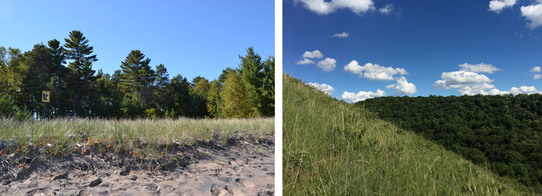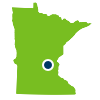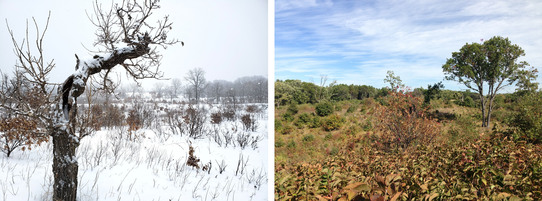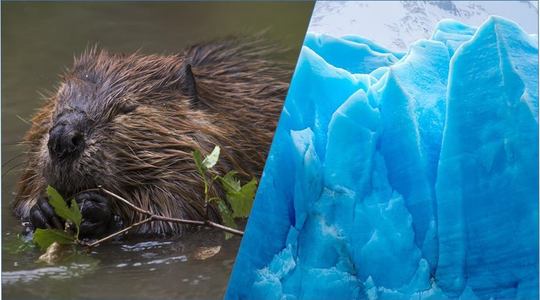Seasonal Wildlife Concentrations – The Longspurs
Second in a 50th anniversary story series highlighting natural features preserved on Minnesota Scientific and Natural Areas
Bob Dunlap, Minnesota Biological Survey
Longspurs are a group of ground-dwelling songbirds that reside in open habitats throughout their North American ranges. So named because their hind toe has an exceptionally long claw, these birds were once thought to be sparrows, which they closely resemble in shape and size. Now known to be members of their own unique family, which also includes Snow Buntings, Longspurs differ significantly from sparrows in that they often form huge flocks, sometimes numbering in the thousands, during migration and winter. Some of the most impressive longspur flocks in Minnesota are encountered in spring in the western half of the state.
Especially during March snowstorms, flocks of migrating longspurs can become “grounded” as inclement weather makes flying inefficient and dangerous. An account by Dr. Thomas S. Roberts, famed Minnesota ornithologist, in The Birds of Minnesota (1932) details at least 750,000 Lapland Longspurs found dead on two frozen lakes in Nobles County on the morning following a mid-March snowstorm in 1904. The hoard of birds likely perished from exhaustion trying to migrate north the previous night.
Lapland Longspur (Calcarius lapponicus). Photo by Bob Dunlap.
There are three species of longspurs found in Minnesota annually. The Lapland Longspur (Calcarius lapponicus) is the most frequently encountered and can be found statewide in migration. In winter, look for this species along roadsides in agricultural areas of the state. It is easy to find them in the fall at Langhei Prairie SNA. The Smith’s Longspur (Calcarius pictus) is rare in Minnesota and most reliably found in late April and early May or mid- to late October in the prairie regions of Minnesota. Look for them especially at places like Rock Ridge Prairie SNA or Mound Spring Prairie SNA in southwestern Minnesota where, if you’re lucky and the timing is right, you might come upon a flock of the birds feeding on the dropped seeds of native grasses. Minnesota’s third species, the Chestnut-collared Longspur (Calcarius ornatus), is a rare and declining breeder in grasslands of northwestern Minnesota. Although birds have occasionally been found elsewhere in the western third of the state during the breeding season, in recent years the species has only been found in the large public and private prairie complex near Felton Prairie SNA. Both Lapland and Smith’s longspurs breed in the northern latitudes of Canada and Alaska. Many SNAs in Minnesota provide important grassland habitats that these species require for stopping along their migration routes.
Native Plant Communities
Third in a 50th anniversary story series highlighting natural features preserved on Minnesota Scientific and Natural Areas
Hannah Texler, Minnesota Biological Survey
One of the features that Scientific and Natural Areas protect is native plant communities. So what are they, and how do we study and define them?
A native plant community is a group of native plants that interact with each other and with their environment in ways not greatly altered by modern human activity or by introduced organisms. They form recognizable units – think prairies or pine forests - that tend to repeat over space and time. Like human communities, they are often complex, constantly changing, and variable.
Many kinds of vegetated areas are not native plant communities. These include planted areas such as orchards and pine plantations, and places where non-native invasive species like buckthorn, smooth brome, or purple loosestrife have mostly replaced native species.
We classify native plant communities, or NPCs, by considering vegetation, hydrology, landforms, soils, and natural disturbance regimes. Examples of natural disturbances include wildfires, severe droughts, windstorms, and floods. The Minnesota DNR developed a new classification of NPCs in 2003, based on analyses of thousands of vegetation plots from all over the state. The DNR maps higher quality NPCs through a Geographic Information System. These maps enable us to make comparisons with natural vegetation occurring in the state in the 1800s. For example, just 2% of the prairie that existed here in the 1800s remains today. The maps also help us to assemble layers of information that point to which sites qualify for SNA designation.
Every Scientific and Natural Area contains NPCs. The SNA website includes them in its description of most sites (some of the descriptions still need to update to the current classification system), and in some cases, the detail maps include simplified NPCs. If you want more in-depth information, there is the Native Plant Community Field Guide for your part of the state, available in many bookstores or through an online order form.
 Left: An old-growth Red Pine - White Pine Woodland transitions to a Beachgrass Dune on the 0.3 mile wide sandbar at Minnesota Point Pine Forest SNA. Right: Bedrock Bluff Prairies grow on the south/west facing bluffs, while the Red Oak – White Oak – Sugar Maple Forest grows on the north/east facing bluffs at Mound Prairie SNA. Photos by Kelly Randall
Let’s take a look at the NPCs found in Minnesota Point Pine Forest SNA, located on a portion of a 7-mile long sandbar that shelters the Duluth Harbor and Superior Bay from the open waters of Lake Superior. Bands of vegetation correspond to the increasingly stable conditions as one moves inland from the water’s edge. Old-growth Red Pine – White Pine Woodland occurs on the more stable interior portions of the sandbar. Wave-washed shoreline and open beach transition to Beachgrass Dune, then to Juniper Dune Shrubland NPCs. The sand substrate, dune formations, and wind are the most important factors determining where NPCs occur here.
Mound Prairie SNA in southeast Minnesota’s Blufflands provides an interesting contrast. Here in this ancient landscape that was missed by the most recent glacial advance, the topography is steep and rocky, and the soils are thin and silty. The slope and the aspect (or which way the bluffs face) are important determinants of NPCs, and the natural disturbance of fire plays an important role. Steep south to west-facing bluffs support Bedrock Bluff Prairies (also known as goat prairies) – dry, rocky prairies with a diverse array of native grasses, sedges, and wildflowers. These prairies burned regularly prior to Eurasian settlement, and are prescribe-burned by SNA management staff today. On the cooler north to east-facing slopes, Red Oak – White Oak – Sugar Maple Forest occurs. The shadier aspect creates conditions for trees to out-compete prairie grasses. Light surface fires once occurred here naturally, but less frequently and less intense than fires on neighboring Bedrock Bluff Prairies.
Next time you are visiting an SNA, take notice of the native plant communities around you, and think about the combination of geology, soil, slope, aspect, hydrology and climate conditions that formed them as well as the natural disturbances that help maintain them today

Site Highlight: Uncas Dunes SNA
David Minor, SNA Web and Social Media Specialist
Minnesota is truly amazing. When you think you have it figured out, just wait, you will find there is yet more, different and undisturbed. You can find this in any season at the Uncas Dunes SNA. Entering the site in winter, skiing through a corridor of oak trees, Minnesota is easily recognizable. It looks like no one has been back here besides a deer, whose path leads through the trees toward a clearing. Snow just begins falling from a sky white with clouds. The true splendor of the site comes when leaving the woodland to stand and look out onto a rolling oak savanna, one of the native plants communities this site protects. This is a different Minnesota.
In the five minutes between leaving the car on the road and skiing through the trees into the opening, the world changes. It is like a place just outside of reality, the only hint of civilization an airplane overhead. Almost like Narnia or Neverland, the dry oak barrens savanna at Uncas Dunes gives you the sense that it is special. The rolling hills, with grasses poking through the top of the snow, and the oak trees reaching out and twisting, free to stretch into the sun any which way. The thick snow dampening all sound. The only noise is the smooth crunch of skis breaking through the crusty top layer of snow, and the airplane, a reminder of the world beyond. It seemed as if no one has been here the entire winter. The snow hasn’t been compacted and would swallow you to your waist if you stepped without skis or snowshoes. The landscape literary draws you in.
Skiing through this wonderland in the thick of winter, a layer of snow building up on the brim of my cap, I thought about the savanna in summer. Walking along the sand dunes, careful not to disturb fragile habitat, seeing skippers dart around the grasses and wildflowers. The oak trees, standing independent of each other, stretching out wide into the open air hold green leaves against a clear blue sky. Bird song cutting through the silence, filling the air with life. It is not the snow sinking me to my knees in winter that keeps me. It will be the same after it all soon melts. It is the inexplicable experience of connecting with the world through the complete absence of humanity.
|
 Dry barrens oak savanna covered in snow in winter. Photo by David Minor. Right: Dry barrens oak savanna in summer. Photo by Kelly Randall.
If you want to go visit the Uncas Dunes SNA, any season will give you a great reward. You can find the dry barrens oak savanna described above, mesic oak woodland, tamarack swamp, alder swamp, sedge meadow, and a rich fen. Camp right next to the SNA at the Ann Lake Campground in Sand Dunes State Forest, where you can go swimming and kayaking. Then spend your day exploring the nearly 750 acre SNA. In the spring and summer you will see hairy puccoon, bearded birdfoot violet, golden aster, Virginia ground cherry, and silky prairie clover growing on the 8000 year old sand dunes left behind from a glacial lake. The site takes its name from the endangered Uncas Skipper, which hasn’t been seen in the state since the 1980s. While you probably won’t see the SNA’s namesake, it is a great spot for bird and wildlife watching. So grab that bird checklist and try to find a Whip-poor-will or one of the other 105 species of birds recorded on the site. Whether you go with binoculars, camera, snowshoes, or just a hiking stick, this SNA has something for you.
SNA Events
Spring time is here! Time to shake off the long winter and stretch. Good thing there are plenty of opportunities to get outside on the SNA Events Calendar this spring! There are volunteering events, educational events, hikes and nature walks, and more! Here is a quick highlight of some of the events coming up, check the website for a more complete list!

New episodes of Prairie Pod podcast are coming out this summer! Catch up on episodes from last season where hosts Megan and Jessica talk to natural resource professionals about anything and everything related to Minnesota’s prairies.
Notes from Site Stewards
Site stewards monitor SNAs across Minnesota. Their observations provide valuable information to the SNA Program. Here are some interesting notes from recent reports:
- Site Steward at Franconia Bluffs SNA, John Wachlarowicz and the St Croix Valley chapter of MN Deer Hunters Association picked up some trash and noted deer and coyote scat and trails on January 13th. They also noted a neighbor from Franconia out photographing.
- Volunteers, led by site steward Jim Smetana, burned brush piles on a cold, windy day on January 26th at Lost Valley Prairie SNA. He notes they had trouble starting one of the fires, but eventually got it started and the weather even warmed up 20 degrees by the end of the day.
- Site Steward Randy McCarty noted that eagles are back building their nest at Chisholm Point Island SNA on March 4th. There were also plenty of snowshoers.
Thanks stewards for all the work you do for SNAs!
|